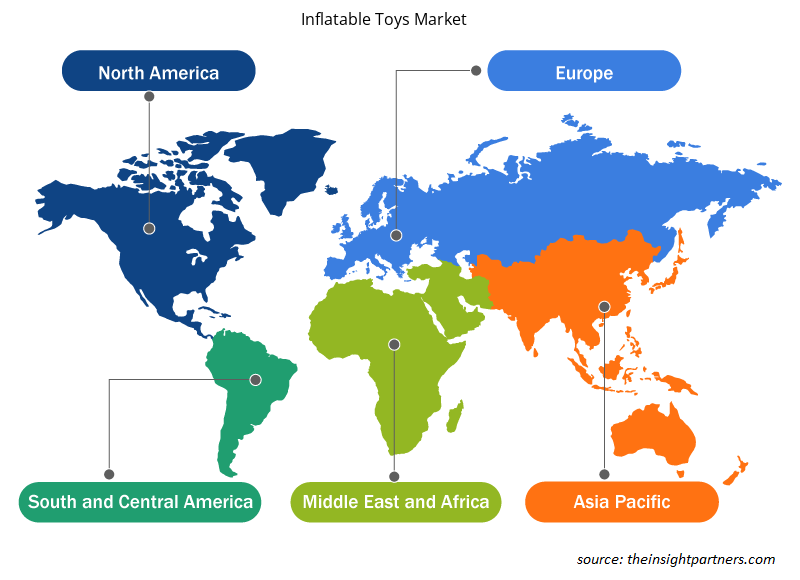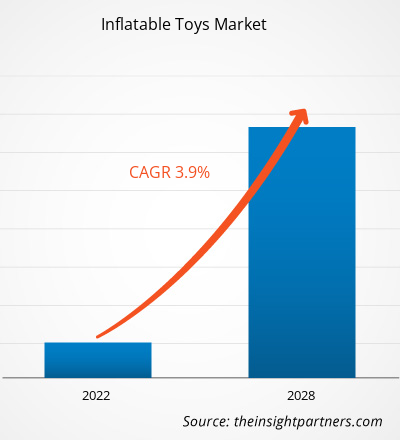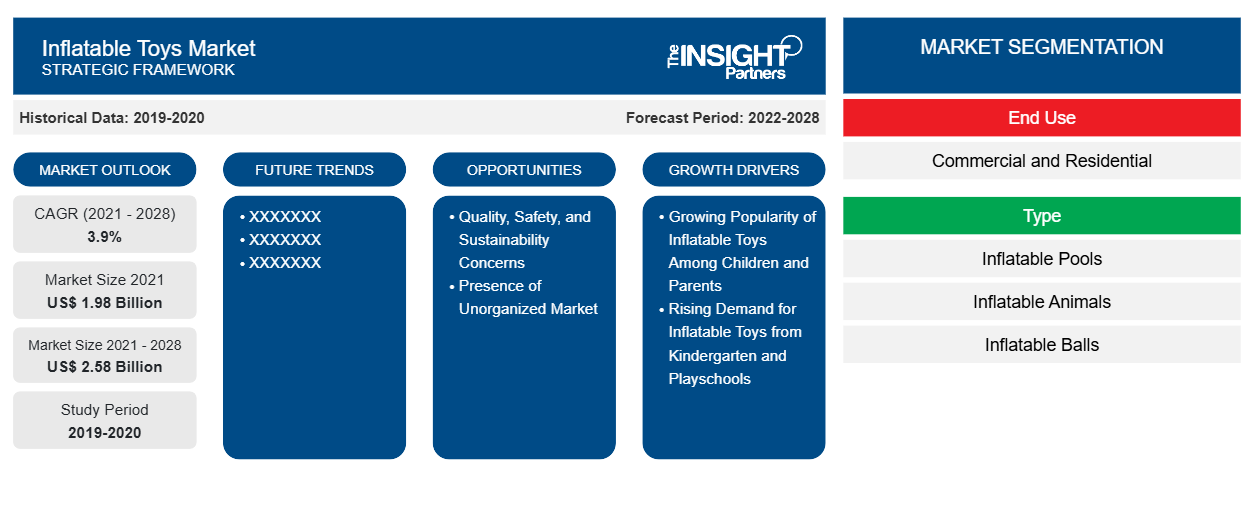[Forschungsbericht] Der Markt für aufblasbares Spielzeug soll von 1.975,13 Millionen US-Dollar im Jahr 2021 auf 2.577,43 Millionen US-Dollar im Jahr 2028 anwachsen; von 2021 bis 2028 wird mit einer durchschnittlichen jährlichen Wachstumsrate von 3,9 % gerechnet.CAGR of 3.9% from 2021 to 2028.
Markteinblicke und Analystenansichten:
Aufblasbare Spielzeuge sind hochelastisch. Aufgrund der kantigen Oberflächen sind sie jedoch anfälliger für Löcher. Hersteller von aufblasbaren Spielzeugen bieten daher Flicken an, um die Löcher abzudecken. Dadurch sind aufblasbare Spielzeuge wiederverwendbar. Zu aufblasbaren Spielzeugen gehören aufblasbare Pools, Tiere, Bälle, Burgen, Spielhäuser usw. Diese Produkte sind tragbar und leicht zu verstauen. Darüber hinaus sind sie leicht zu installieren, sodass sie sich für den Einsatz im Wohnbereich eignen. Aufblasbare Spielzeuge werden im Allgemeinen aus Polyvinylchlorid hergestellt. Die steigende Nachfrage nach verschiedenen innovativen Spielzeugen wird voraussichtlich das Wachstum von aufblasbaren Spielzeugen im Prognosezeitraum vorantreiben.
Wachstumstreiber und Herausforderungen:
Spielzeug spielt eine entscheidende Rolle bei der körperlichen und kognitiven Entwicklung eines Kindes. Es fördert die Kreativität und Vorstellungskraft von Kindern. In den letzten Jahren haben aufblasbare Spielzeuge, insbesondere aufblasbare Pools und Rutschen, bei Kindern und Eltern enorm an Beliebtheit gewonnen. Kinder spielen gern im Wasser. Wasserspiele helfen auch dabei, die Koordination und körperliche Fitness von Kindern zu verbessern. Aufblasbare Pools und Rutschen sind sehr erschwinglich und einfach aufzubauen. Darüber hinaus können sie je nach verfügbarem Platz problemlos in kleinen bis mittelgroßen Räumen aufgestellt werden. Aufblasbare Pools sind tragbar und erfordern sehr wenig Pflege oder Wartung. All diese Faktoren machen aufblasbare Pools und Rutschen bei Eltern und Kindern beliebt.
Die zunehmende Verbreitung von E-Commerce-Plattformen bietet dem Markt für aufblasbares Spielzeug ebenfalls ein starkes Wachstumspotenzial. Immer mehr Menschen kaufen aufblasbares Spielzeug lieber auf Online-Shopping-Websites, da sie bequem eine große Produktpalette zu erschwinglichen Preisen aus der Ferne kaufen können. Darüber hinaus verbessern die Verfügbarkeit von Produktbeschreibungen, Details, Kundenrezensionen und -bewertungen sowie mehrere Zahlungskanäle das Einkaufserlebnis der Kunden, was zu mehr Online-Verkäufen von aufblasbarem Spielzeug führt. Daher wird erwartet, dass der steigende Umsatz mit aufblasbarem Spielzeug über E-Commerce-Websites wie Amazon.com, Walmart, Home Depot und Direkt-an-Kunden-Shopping-Sites der Hersteller in der kommenden Zeit enorme Wachstumschancen auf dem Markt für aufblasbares Spielzeug eröffnen wird .Amazon.com, Walmart, the Home Depot, and direct-to-customer shopping sites of the manufacturers is expected to open immense growth opportunities in the
Passen Sie diesen Bericht Ihren Anforderungen an
Sie erhalten kostenlos individuelle Anpassungen an jedem Bericht, einschließlich Teilen dieses Berichts oder einer Analyse auf Länderebene, eines Excel-Datenpakets sowie tolle Angebote und Rabatte für Start-ups und Universitäten.
-
Holen Sie sich die wichtigsten Markttrends aus diesem Bericht.Dieses KOSTENLOSE Beispiel umfasst eine Datenanalyse von Markttrends bis hin zu Schätzungen und Prognosen.
Berichtssegmentierung und -umfang:
Der „globale Markt für aufblasbares Spielzeug“ ist nach Endverbrauch, Typ, Vertriebskanal und Geografie segmentiert. Basierend auf der Endnutzung wird der Markt in gewerblich und privat kategorisiert. Basierend auf dem Typ ist der Markt für aufblasbares Spielzeug in aufblasbare Pools, aufblasbare Tiere, aufblasbare Bälle und andere segmentiert. Basierend auf dem Vertriebskanal ist der Markt für aufblasbares Spielzeug in Supermärkte und Hypermärkte, Fachgeschäfte, Online-Einzelhandel und andere segmentiert. Basierend auf der Geografie ist der Markt für aufblasbares Spielzeug in Nordamerika (USA, Kanada und Mexiko), Europa (Deutschland, Frankreich, Italien, Großbritannien, Russland und Rest von Europa), Asien-Pazifik (Australien, China, Japan, Indien, Südkorea und Rest von Asien-Pazifik), Naher Osten und Afrika (Südafrika, Saudi-Arabien, Vereinigte Arabische Emirate und Rest von Nahem Osten und Afrika) und Süd- und Mittelamerika (Brasilien, Argentinien und Rest von Süd- und Mittelamerika) segmentiert.UAE, and Rest of Middle East & Africa), and South & Central America (Brazil, Argentina, and Rest of South & Central America)
Segmentanalyse Analysis
Basierend auf der Endnutzung ist der Markt für aufblasbares Spielzeug in Wohn- und Gewerbebereich unterteilt. Basierend auf dem Typ ist der Markt in aufblasbare Pools, aufblasbare Tiere, aufblasbare Bälle und andere segmentiert. Basierend auf dem Vertriebskanal ist der Markt für aufblasbares Spielzeug in Supermärkte und Hypermärkte, Fachgeschäfte, Online-Einzelhandel und andere segmentiert. Das Segment der Fachgeschäfte hält den größten Anteil am Markt für aufblasbares Spielzeug und das Segment des Online-Einzelhandels wird im Prognosezeitraum voraussichtlich ein erhebliches Wachstum verzeichnen. Fachgeschäfte haben ein breites Sortiment spezifischer Produktkategorien mit unterschiedlichen Preisspannen von billiger bis hochwertig. Fachgeschäfte sind bevorzugte Einkaufsplattformen für aufblasbares Spielzeug, da die Menschen unter einem Dach auf mehrere Marken aufblasbaren Spielzeugs zugreifen können. Darüber hinaus verfügen diese Geschäfte über sachkundiges Personal, das den Kunden bei der Suche nach den richtigen Produkten hilft. Die Verfügbarkeit einer breiten Produktpalette verschiedener Marken und kooperatives Personal erhöht die Kundenzufriedenheit, was zu erhöhten Verkäufen von aufblasbarem Spielzeug über Fachgeschäfte führt. Diese Faktoren treiben das Wachstum des Segments erheblich voran und treiben letztendlich den Markt für aufblasbares Spielzeug an.
Regionale Analyse:
Geografisch ist der Markt für aufblasbares Spielzeug in fünf Hauptregionen unterteilt: Nordamerika, Europa, Asien-Pazifik, Süd- und Mittelamerika sowie Naher Osten und Afrika. Der globale Markt für aufblasbares Spielzeug wurde von Nordamerika dominiert, das im Jahr 2022 704,25 Millionen US-Dollar ausmachte. Der Asien-Pazifik-Raum ist ein zweiter wichtiger Beitragszahler mit einem Anteil von mehr als 30 % am Weltmarkt. Darüber hinaus wird für Europa im Prognosezeitraum ein deutliches Wachstum mit einer durchschnittlichen jährlichen Wachstumsrate von 4,6 % erwartet. Die Präsenz mehrerer Themenparks und Wasserparks, darunter Parks von Anbietern wie Cedar Fair Entertainment, SeaWorld Parks & Entertainment, Universal Parks & Resorts und Walt Disney Parks and Resorts in Ländern Nordamerikas, wird der Hauptfaktor sein, der das Wachstum des Marktes für aufblasbares Spielzeug in dieser Region ankurbelt. Darüber hinaus wird die zunehmende Zahl von Kindergärten und Spielschulen in der Region in der Folge zu einer kommerziellen Nutzung von aufblasbarem Spielzeug in Nordamerika führen. Diese Faktoren werden voraussichtlich die Nachfrage nach aufblasbarem Spielzeug bei den Verbrauchern in der Region steigern und das Marktwachstum weiter vorantreiben.CAGR of 4.6% over the forecast period. The presence of several theme-based parks and water parks, including parks from vendors such as Cedar Fair Entertainment, SeaWorld Parks & Entertainment, Universal Parks & Resorts, and Walt Disney Parks and Resorts in countries in North America, will be the major factor fueling the growth of the inflatable toys market in this region. Furthermore, the increasing number of kindergartens and playschools in the region will subsequently lead to commercial usage of inflatable toys in North America. These factors are expected to boost the demand for inflatable toys among consumers in the region and are further anticipated to drive the market growth.
Branchenentwicklungen und zukünftige Chancen:
Nachfolgend sind verschiedene Initiativen der wichtigsten Akteure auf dem Markt für aufblasbares Spielzeug aufgeführt:
- Amazon eröffnete im November 2020 einen speziellen Shop namens „Made in India Toys and Games“ für kleine Unternehmen, die indisches Spielzeug verkaufen. Damit unterstützte der Online-Händler die lokalen Akteure, indem er ihnen eine bessere Entdeckung und den Verkauf von lokal hergestelltem und entworfenem Spielzeug ermöglichte.
- Im Jahr 2019 eröffnete Bestway Inflatables and Material Corp., ein in China ansässiger Hersteller von aufblasbaren Outdoor- und Freizeitprodukten, seine brandneue Fabrik in Vietnam.
Regionale Einblicke in den Markt für aufblasbares Spielzeug
Die regionalen Trends und Faktoren, die den Markt für aufblasbares Spielzeug im Prognosezeitraum beeinflussen, wurden von den Analysten von Insight Partners ausführlich erläutert. In diesem Abschnitt werden auch die Marktsegmente und die Geografie von aufblasbarem Spielzeug in Nordamerika, Europa, im asiatisch-pazifischen Raum, im Nahen Osten und Afrika sowie in Süd- und Mittelamerika erörtert.

- Erhalten Sie regionale Daten zum Markt für aufblasbares Spielzeug
Umfang des Marktberichts für aufblasbares Spielzeug
| Berichtsattribut | Details |
|---|---|
| Marktgröße im Jahr 2021 | 1,98 Milliarden US-Dollar |
| Marktgröße bis 2028 | 2,58 Milliarden US-Dollar |
| Globale CAGR (2021 - 2028) | 3,9 % |
| Historische Daten | 2019-2020 |
| Prognosezeitraum | 2022–2028 |
| Abgedeckte Segmente |
Nach Endverwendung
|
| Abgedeckte Regionen und Länder |
Nordamerika
|
| Marktführer und wichtige Unternehmensprofile |
|
Dichte der Marktteilnehmer für aufblasbares Spielzeug: Die Auswirkungen auf die Geschäftsdynamik verstehen
Der Markt für aufblasbare Spielzeuge wächst rasant, angetrieben durch die steigende Nachfrage der Endverbraucher aufgrund von Faktoren wie sich entwickelnden Verbraucherpräferenzen, technologischen Fortschritten und einem größeren Bewusstsein für die Vorteile des Produkts. Mit steigender Nachfrage erweitern Unternehmen ihr Angebot, entwickeln Innovationen, um die Bedürfnisse der Verbraucher zu erfüllen, und nutzen neue Trends, was das Marktwachstum weiter ankurbelt.
Die Marktteilnehmerdichte bezieht sich auf die Verteilung der Firmen oder Unternehmen, die in einem bestimmten Markt oder einer bestimmten Branche tätig sind. Sie gibt an, wie viele Wettbewerber (Marktteilnehmer) in einem bestimmten Marktraum im Verhältnis zu seiner Größe oder seinem gesamten Marktwert präsent sind.
Die wichtigsten auf dem Markt für aufblasbares Spielzeug tätigen Unternehmen sind:
- Intex Marketing Ltd
- Bestway Aufblasartikel und Material Corp.
- Aufblasbares Spielzeug von Happy Inflatables
- Kleine Tikkes
- Aufblasbares Zubehör
Haftungsausschluss : Die oben aufgeführten Unternehmen sind nicht in einer bestimmten Reihenfolge aufgeführt.

- Überblick über die wichtigsten Akteure auf dem Markt für aufblasbares Spielzeug
Auswirkungen von Covid-19:
Die COVID-19-Pandemie betraf fast alle Branchen in zahlreichen Ländern. Lockdowns, Reisebeschränkungen und Betriebsschließungen in Nordamerika, Europa, Asien-Pazifik (APAC), Süd- und Mittelamerika (SAM) sowie dem Nahen Osten und Afrika (MEA) behinderten das Wachstum mehrerer Branchen, darunter auch der Konsumgüterindustrie. Die Schließung von Produktionseinheiten störte globale Lieferketten, Fertigungsaktivitäten, Lieferpläne sowie den Verkauf lebensnotwendiger und nicht lebensnotwendiger Produkte. Verschiedene Unternehmen erlebten im Jahr 2020 Verzögerungen bei Produktlieferungen und einen Einbruch der Verkäufe ihrer Produkte. Aufgrund der pandemiebedingten Wirtschaftsrezession wurden die Verbraucher bei ihren Kaufentscheidungen vorsichtiger und selektiver. Aufgrund niedrigerer Einkommen und unsicherer Verdienstaussichten, insbesondere in Entwicklungsregionen, reduzierten die Verbraucher ihre nicht lebensnotwendigen Einkäufe erheblich. Aufgrund von Reiseverboten und Grenzbeschränkungen gingen die Freizeitaktivitäten drastisch zurück, was den Verkauf verschiedener aufblasbarer Spielzeuge behinderte.
Viele Hersteller von aufblasbaren Spielzeugen mussten aufgrund der geringeren Verbrauchernachfrage in der Anfangsphase der Pandemie sinkende Gewinne verzeichnen. Bis Ende 2021 waren jedoch viele Länder vollständig geimpft und die Regierungen kündigten Lockerungen bestimmter Vorschriften an, darunter Ausgangssperren und Reiseverbote. All diese Faktoren wirkten sich positiv auf das Wachstum des Marktes für aufblasbare Spielzeuge in verschiedenen Regionen aus.
Wettbewerbslandschaft und Schlüsselunternehmen:
Zu den führenden Akteuren auf dem globalen Markt für aufblasbares Spielzeug gehören unter anderem Intex Recreation Corp.; Bestway Inflatables & Material Corp.; Happy Inflatable Co. Ltd; LIttle Tikes; General Inflatables; Joyin; Omega Inflatables Factory; HearthSong; Waddle & Friends, Inc.; Jet Creations Inc. Diese Akteure bieten aufblasbares Spielzeug mit innovativen Funktionen an, um eine große Zahl von Verbrauchern anzulocken.
- Historische Analyse (2 Jahre), Basisjahr, Prognose (7 Jahre) mit CAGR
- PEST- und SWOT-Analyse
- Marktgröße Wert/Volumen – Global, Regional, Land
- Branchen- und Wettbewerbslandschaft
- Excel-Datensatz
Aktuelle Berichte
Verwandte Berichte
Erfahrungsberichte
Grund zum Kauf
- Fundierte Entscheidungsfindung
- Marktdynamik verstehen
- Wettbewerbsanalyse
- Kundeneinblicke
- Marktprognosen
- Risikominimierung
- Strategische Planung
- Investitionsbegründung
- Identifizierung neuer Märkte
- Verbesserung von Marketingstrategien
- Steigerung der Betriebseffizienz
- Anpassung an regulatorische Trends























 Kostenlose Probe anfordern für - Markt für aufblasbares Spielzeug
Kostenlose Probe anfordern für - Markt für aufblasbares Spielzeug